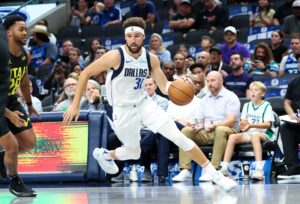The Toronto Raptors’ acquisitions of power forward Serge Ibaka and small forward P.J. Tucker significantly increased the team’s chances of returning to the Eastern Conference Finals. In part one of a two-part series, let’s look at what Ibaka brings to the table for the Dinos, especially in the wake of the injury to star point guard Kyle Lowry.
Evaluating the Toronto Raptors’ Trade Acquisitions: Part One – Serge Ibaka
Rim Protection
Throughout his eight-year career, Ibaka’s defensive prowess has been his trademark. The Congolese big man came into the league as a raw, muscular 20-year-old, displaying his potential early on in his rookie season. In a game against the Los Angeles Lakers in November 2009, he hauled in 13 rebounds and blocked five shots while coming off the bench.
Since then, Ibaka has evolved as a player, ranking top five in blocks per game in five of the past seven seasons. He reached his shot-blocking peak in the 2012-13 and 2013-14 seasons, leading the league in blocks per game for each of those years.
Ibaka immediately addresses the Raptors’ interior defensive issues. Before acquiring the big man, Toronto’s best shot blocker was Lucas Nogueira, the team’s backup center who plays just 21 minutes per game. Aside from Nogueira, no one on the team averages more than one block per game. The two closest are energetic power forward Pascal Siakam (0.9 BPG) and starting center Jonas Valanciunas (0.7 BPG).
In his first three games with the team, Ibaka has already shown flashes of defensive dominance. During the Raps’ matchup with the Trail Blazers on February 25th, there was one instance midway through the second quarter in which Ibaka simply elevated high above Portland center Jusuf Nurkic, preventing him from getting his shot off at the rim. Plays like that not only cause fans to drop their popcorn, but also show just how valuable the big man can be as Toronto’s defensive anchor.
While Ibaka may be listed as a power forward, he has shown time and time again the ability to slide to the five and guard centers, with – you guessed it – well above-average rim protection. His nickname, “IBLOCKA,” is well-deserved.
Floor Spacing
At the start of his career, a consistent jump shot was not part of Ibaka’s offensive arsenal. Oh, how the times have changed. Not only can Ibaka consistently knock down mid-range jumpers, but he’s even stretched his range out beyond the three-point arc.
In his first three NBA seasons, the former Oklahoma City Thunder star attempted six three-pointers total. As the NBA has evolved into its current iteration – one that emphasizes a high volume of three-point shots – so, too, has Ibaka’s game.
Since the 2012-13 season, Ibaka has shot 734 three-pointers, converting on 36 percent of them. While the Raptors are already a solid three-point shooting team, making 37 percent of their three-pointers (9th in the NBA), Ibaka’s consistent shooting touch can’t hurt.
Rebounding
Ibaka averages 7.3 boards per game for his career. Even when he doesn’t haul in a rebound himself, he’s often in on the action, elevating above the nine other players on the court to tip a rebound to a teammate. He did that multiple times during the Raptors’ match-up against the Trail Blazers.
The Raptors rank 25th in the league in total rebounds, hauling in 42.5 per game. Ibaka should help the team patch up that issue.
How Should Head Coach Dwane Casey Utilize Ibaka?
Given the fact that Ibaka has only played three games with Toronto, Head Coach Dwane Casey is still seeking out ways to utilize the power forward most effectively.
With Lowry likely out for the rest of the regular season (or close to it), Casey needs to increase Ibaka’s role on offense. Ibaka should be the clear number two scoring option behind DeMar DeRozan. Casey could run more plays for Ibaka, emphasizing the 6’10” forward’s strength in the paint. Most of the time, Ibaka’s strength alone will allow him to beat his defender to the cup.
Furthermore, when Ibaka does enter the post, he’s not always looking to score. In Toronto’s game against Portland, Ibaka found Valanciunas inside, creating excellent post position for his frontcourt partner. Valanciunas finished the game with 15 points, on an extremely efficient 7-of-8 from the field. Casey should explore the two-man game between the team’s big men even further.
All stats are accurate as of February 28th.
Part two of this series will focus on P.J. Tucker, the Raptors’ second acquisition prior to the trade deadline.






